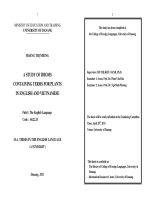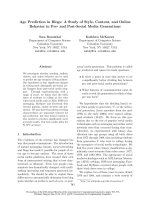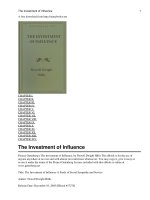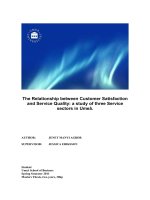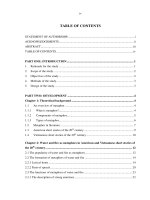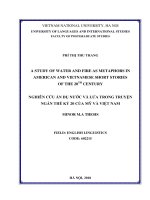A study of customer satisfaction towards service quality in vietnamairlines
Bạn đang xem bản rút gọn của tài liệu. Xem và tải ngay bản đầy đủ của tài liệu tại đây (1.4 MB, 83 trang )
RESEARCH PROJECT
(BMBR5103)
A STUDY OF CUSTOMER SATISFACATON TOWARDS SERVICE QUALITY
IN VIETNAMAIRLINES
STUDENT’S FULL NAME
: DANG TIEN MANH
STUDENT ID
: CGS00064962
INTAKE
: March, 2016
ADVISOR’S NAME & TITLE
: Dr. BUI PHI HUNG
July, 2017
Advisor’s assessment
............................................................................................................................................
............................................................................................................................................
............................................................................................................................................
............................................................................................................................................
............................................................................................................................................
............................................................................................................................................
............................................................................................................................................
............................................................................................................................................
............................................................................................................................................
............................................................................................................................................
............................................................................................................................................
............................................................................................................................................
............................................................................................................................................
............................................................................................................................................
............................................................................................................................................
............................................................................................................................................
............................................................................................................................................
............................................................................................................................................
............................................................................................................................................
............................................................................................................................................
............................................................................................................................................
Advisor’s signature
ACKNOWLEDGEMENT
I would like to express my grateful to all persons who gave me the possibility to complete
this study.
First and foremost, I want to give big thanks to lectures in MBA OUM program in Ho
Chi Minh City, especially the lectures in Business Administration Faculty, who have
imparted knowledge and valuable experiences to us.
I would like to express my whole-hearted gratefulness to my supervisor, Mr. Bui Phi
Hung, who guided us to complete my research project.
Besides, we are also very thankful to all the respondents for giving their precious time to
complete the questionnaires and fill up the respond sincerely.
Furthermore, we would like to appreciate to all our friends for their continuous support
and assistance during the progress of research.
Once again, I hope the lectures have a good health and success for both life and career.
Thank you very much!
Ho Chi Minh, 2017
ABSTRACT
In service industries Customer satisfaction plays a very significant role. Several authors
had believed that Customer satisfaction and service quality are inter-related.The purpose
of this study mainly focuses on the customer satisfaction levels in Airline sector in
context with VietnamAirlines in Viet Nam. In order to determine the satisfaction levels of
its customers in VietnamAirlines the author in this thesis work had adopted exploratory
method of approach and adopted quantitative methodology to evaluate the existing
relationship between the Customer satisfaction and service quality measurement in
VietnamAirlines. The author had gathered
primary data in the form of conducting
questionnaires and a survey of travellers flying through VietnamAirlines and also relied
on secondary data resources such as journals, books, articles for the purpose of the
research study. Finally the researcher could establish the aims and objectives in Research
findings by applying Paired Sample test in SPSS application and had concluded the work
by mentioning existing limitations and future recommendations.
List of Tables
Table
Page
Table 3.1: Result of Pilot Test
26
Table 3.2: Origin of Constructs
27
Table 4.1 Gender of respondents
34
Table 4.2 Age of respondents
35
Table 4.3 Marital Status of respondents
36
Table 4.4 Work status of respondents
37
Table 4.5 Income of respondents
38
Table 4.6 Reliability Statistics for each of the variable
45
Table 4.7 Pearson Correlation
46
Table 4.8 Model Summary
46
Table 4.9 ANOVA test
47
Table 4.10 Coefficients
48
List of Figures
Figures
Page
Figure 2.1: A study of customer satisfaction toward service quality of
14
VietnamAirlines.
Figure 4.1 Gender of respondents
34
Figure 4.2 Age of respondents
35
Figure 4.3 Marital Status of respondents
36
Figure 4.4 Work status of respondents
37
Figure 4.5 Income of respondents
38
Figure 4.2.2.1 Ever travelled by air
39
Figure 4.2.2.2: Travelling by VietnamAirlines
40
Figure 4.2.2.3: Travel regularly
40
Figure 4.2.2.4: Times travel in a year
41
Figure 4.2.2.5: Class of airline
42
Figure 4.2.2.6: Airline tickets
43
Figure 4.2.2.7: Categorize of air travel
44
TABLE OF CONTENTS
CHAPTER 1: INTRODUCTION ........................................................................................ 1
1.1 Research Background................................................................................................. 1
1.2. Research Objectives .................................................................................................. 2
1.2.1 General Objectives ............................................................................................... 2
1.2.2 Specific Objectives .............................................................................................. 3
1.3 Research Questions .................................................................................................... 3
1.4 Hypotheses of the Study............................................................................................. 3
1.5. Significance of the Study .......................................................................................... 4
1.6 Chapter Layout ........................................................................................................... 4
1.7 Conclusion.................................................................................................................. 5
2.1 Introduction ................................................................................................................ 6
2.2 Background of VietnamAirlines ................................................................................ 6
2.2.1 History and milestones: ....................................................................................... 6
2.2.2 Major Operations ................................................................................................. 7
2.3 Review of Literature .................................................................................................. 7
2.3.1 Customer Satisfaction .......................................................................................... 7
2.3.2 Service Quality .................................................................................................... 9
2.3.2.1 Dimensions of Service Quality................................................................... 10
2.3.2.2 Determinants of Service Quality ................................................................ 12
2.4 Customer Satisfaction and Service Quality Measurement in VietnamAirlines ....... 12
2.5 Proposed Theoretical / Conceptual Framework ....................................................... 13
2.6 Hypotheses Development......................................................................................... 14
2.6.1 Relationship between tangible features and customer satisfaction ................... 14
2.6.2 Relationship between schedule and customer satisfaction ................................ 15
2.6.3 Relationship between ground staff and customer satisfaction........................... 16
2.6.4 Relationship between flight attendants and customer satisfaction. ................... 17
2.6.5 Relationship between online services and customer satisfaction. ..................... 18
2.6.6 Relationship between food services and customer satisfaction. ........................ 19
2.7 Conclusion ............................................................................................................ 19
CHAPTER 3: METHODOLOGY ..................................................................................... 21
3.1 Introduction .............................................................................................................. 21
3.2 Research Design ....................................................................................................... 21
3.3 Data Collection Method ........................................................................................... 21
3.3.1 Primary Data ...................................................................................................... 22
3.3.2 Secondary Data .................................................................................................. 22
3.4 Sampling Design ...................................................................................................... 22
3.4.1 Target Population ............................................................................................... 23
3.4.2 Sampling Frame and Sampling Location .......................................................... 23
3.4.3 Sampling Element .............................................................................................. 23
3.4.4 Sampling Size .................................................................................................... 23
3.5 Research Instrument ................................................................................................. 24
3.5.1 Pilot Test ............................................................................................................ 25
3.6 Constructs Measurement .......................................................................................... 27
3.6.1 Scale Measurement ............................................................................................ 28
3.7 Data Processing ........................................................................................................ 28
3.7.1 Questionnaire Checking ..................................................................................... 28
3.7.2 Data Editing ....................................................................................................... 28
3.7.3 Data Coding ....................................................................................................... 29
3.7.4 Data Transcribing .............................................................................................. 29
3.7.5 Data Cleaning .................................................................................................... 29
3.8 Data analysis ............................................................................................................ 29
3.8.1 Descriptive Analysis .......................................................................................... 30
3.8.2 Scale Measurement ............................................................................................ 30
3.8.3 Reliability Test ................................................................................................... 31
3.8.4 Inferential Analysis ............................................................................................ 31
3.8.4.1 Pearson Correlation Coefficient Analysis .................................................. 31
3.8.4.2 Multiple Regressions Analysis ................................................................... 32
3.9 Conclusion................................................................................................................ 32
CHAPTER 4: DATA ANALYSIS .................................................................................... 33
4.1 Introduction .............................................................................................................. 33
4.2 Descriptive Analysis ................................................................................................ 33
4.2.1 Respondent’s Demographic profile ................................................................... 33
4.2.2 Frequencies Table of General Information ........................................................ 39
4.3 Inferential Analysis .................................................................................................. 44
4.3.1 Reliablity Test .................................................................................................... 44
4.4 Inferential Analysis .................................................................................................. 45
4.4.1 Pearson Correlation Analysis ............................................................................ 45
4.4.2 Multiple Regressions Analysis .......................................................................... 46
4.4.2.1 Test of Significant ...................................................................................... 47
4.4 Conclusions .............................................................................................................. 50
CHAPTER 5: DISCUSSION, CONCLUSION AND IMPLICATIONS ......................... 52
5.1 Introduction .............................................................................................................. 52
5.2 Summary of Statistical Analysis .............................................................................. 52
5.2.1 Descriptive Analysis .......................................................................................... 52
5.2.2 Scale Measurement ............................................................................................ 53
5.3 Inferential Analysis .................................................................................................. 53
5.3.1 The Pearson Correlation Analysis ..................................................................... 53
5.3.2 Multiple Regression Analysis ............................................................................ 53
5.4 Discussions of the Major Findings ........................................................................... 54
5.4.1 Hypothesis 1 ...................................................................................................... 54
5.4.2 Hypothesis 2 ...................................................................................................... 54
5.4.3 Hypothesis 3 ...................................................................................................... 55
5.4.4 Hypothesis 4 ...................................................................................................... 56
5.4.5 Hypothesis 5 ...................................................................................................... 57
5.4.6 Hypothesis 6 ...................................................................................................... 57
5.5 Implications of the Study ......................................................................................... 58
5.5.1 Managerial Implications .................................................................................... 58
5.6 Limitations of the Study ........................................................................................... 59
5.7 Recommendations for Future Research ................................................................... 60
5.8 Conclusion................................................................................................................ 61
REFERENCES .................................................................................................................. 62
APPENDICES ................................................................................................................... 66
CHAPTER 1: INTRODUCTION
1.1 Research Background
Nowaday, aviation sector is one of the most importance industry sectors. In services,
airline sector plays a predominant role. It promotes tourism, international investments
and globalisation which contribute to the economic growth of a country
Many researchers and analysts believed that customer beliefs and awareness play an
important role in Service industry. It is also considered that Service quality is the
fundamental aspect of strategic management and marketing for firms in service sector.
Customer satisfaction and reliability as a result of high quality, ensures long term growth
and success. If service sector has to carry on its growth it has to focus on offering
excellent customer service and improve customer satisfaction by analysing their needs,
understanding their perceptions and meeting them. Determining customer demands and
observations in airline industry is really tricky as customer satisfaction is ascertained by
several insubstantial aspects ambiance of the cabin, quality of food served in the flights to
name a few.
Customer satisfaction is one of the foremost major processes in aviation industry and is
established as most vital to the success of business competition. The terms customer
satisfaction and service quality have been both explained as meeting the expectation of
the service with thatwhich is really experienced by the end user. As a result, when
consumer spractices meet or exceed their expectations, the service is observed as a
quality service and there cipients are usually satisfied customers. On the other hand,
when the service experienced by customers is below than their expectations, the
perception of service quality is affected and customers are usually not satisfied.
In the airline sector, judging what passenger wants and imagine is necessary to deliver
excellent customer service and quality and subsequently to analyse the firm s
performance standards. Of late, Air travel industry has been in the news very often for
DANG TIEN MANH
Page 1
various reasons. As per the recent studies conducted by several researcher, business
analysts, media and top management in aviation sector it is understood that the potential
expansion of airline industry is in risk. In order to stabilise and improve the growth of
aviation sector it is understood that major focus should be laid on Customer satisfaction
and Customer relationship management.
This is the reason why the topic : " A study of customer satisfacation towards service
quality in VietnamAirlines ’’ is studied.
1.2. Research Objectives
1.2.1 General Objectives
The purpose of this study is to identify the relationship of the factors that affects the
customer satisfaction and service quality in VietnamAirlines. The factors include tangible
features, schedule, services provided by ground staff, services provided by flight
attendants, online services and food services.
In terms of tangible features, several researcher have agreed that not only the planes and
the flight scheduling, but other tangible and intangible factors such as ticket price, in
flight service, employee attitudes, facilities and the ticket procedures are key contributing
factors which influence the decision making to select the airlines service.
Besides, the flight schedule is anticipated by most of the airline travelers. Regarding the
recovery expectations, recovery performance and justice realistic must be address to
passengers when there is a flight delay or cancellation.
Moreover, services provided by ground staff are actually evaluated by the real services
that given in terms of the flight context which will gain the satisfaction of the passengers
for the overall flight experiences.
Conversely, the services provided by flight attendants about the flight schedule or the
individual attention might produce a greater satisfaction and also with an optimistic
emotion linked during the flight.
DANG TIEN MANH
Page 2
Finally, food services is crucial as it is associated as the basic human need for life
nutrition and long life.
1.2.2 Specific Objectives
(i)
To identify the degree of tangible features towards customer satisfaction in service
quality of VietnamAirlines.
(ii)
To identify the degree of schedules towards customer satisfaction in service
quality of VietnamAirlines.
(iii)
To identify the degree of services provided by ground staff towards customer
satisfaction in service quality of VietnamAirlines.
(iv)
To identify the degree of services provided by flight attendants towards customer
satisfaction in service quality of VietnamAirlines.
(v)
To identify the degree of online services towards customer satisfaction in service
quality of VietnamAirlines.
(vi)
To identify the degree of food services towards customer satisfaction in service
quality of VietnamAirlines.
1.3 Research Questions
(i) How can customer satisfaction in service quality of VietnamAirlines be improved?
(ii) Do tangible features, schedules, services provided by ground staff, services provided
by flight attendants, online services and food services affect customer satisfaction in
service quality of VietnamAirlines?
1.4 Hypotheses of the Study
There are six hypotheses that have been derived in this study namely:
H1- There is a positive relationship between tangible features and customer satisfaction
in service quality of VietnamAirlines.
DANG TIEN MANH
Page 3
H2- There is a positive relationship between schedules and customer satisfaction in
service quality of VietnamAirlines.
H3- There is a positive relationship between services provided by ground staff and
customer satisfaction in service quality of VietnamAirlines.
H4- There is a positive relationship between services provided by flight attendants and
customer satisfaction in service quality of VietnamAirlines.
H5- There is a positive relationship between online services and customer satisfaction in
service quality of VietnamAirlines.
H6- There is a positive relationship between food services and customer satisfaction in
service quality of VietnamAirlines.
1.5. Significance of the Study
This thesis has some theoretical meanings as well as practical implications for companies
on market research, practitioners as well as researcher in the field of service quality and
designing tools to measure customer perceptions.
The research results will help Vietnam Airlines have more information and understanding
of the main factors affecting the customer's perception of the quality of services provided
by the Corporation. Refer to the research results and comments, the Corporation can
adjust, build or redesign the advertising program, policies related to quality of service,
training programs and service processes, to better fit, better meet the expectations of
customers.
Finally, this research can be used as reference material for students with major in
business administration on the basic theory of service quality.
1.6 Chapter Layout
Generally this study consists of five chapters as listed below:
DANG TIEN MANH
Page 4
Chapter 1: Introduction It is the synopsis of the study. It provides research background,
problem statement, research objectives, research questions, hypothesis of the study, and
significance of the study, chapter layout and conclusion.
Chapter 2: Literature Review It discusses the literature review of this study. Besides, the
theoretical model and the conceptual framework are proposed for further study. The
hypothesis development for this study is conducted.
Chapter 3: Research Methodology It is mainly about the research methodology. In this
chapter, it provides the discussion on how the study is conducted and its descriptions by
using research design, data collection methods, sampling design, research instrument and
construct measurement (scale and operation definitions). Furthermore, it discusses about
the data processing and data analysis.
Chapter 4: Data Analysis Description analysis is conducted in which it includes the
respondent demographic profile and central tendencies measurement of constructs.
Furthermore, discussion of scale measurement is provided with the result of the reliability
analysis and inferential analyses which will be used to examine the individual variables
and its relationship with other variables.
Chapter 5: Discussion and Conclusion It outlines the discussions, conclusion and
implications of this study. In this chapter, it provides a summary on statistical analyses
and the discussions on the major findings. Besides, it provides the implications and
limitations of the study as well as recommendation for future research. Furthermore, there
will be an overall conclusion of the entire study.
1.7 Conclusion
This study has examined the study of customer satisfaction towards service quality in
VietnamAirlines. The problem statement, research objectives, research questions and
hypotheses have been developed based on previous literature. Additionally, the next
chapter will discuss in depth on each of the variables and the proposed conceptual
framework.
DANG TIEN MANH
Page 5
CHAPTER 2: LITERATURE REVIEW
2.1 Introduction
Published articles, journals and books were collected to investigate the theories and past
empirical studies which are related to this study. This chapter consists of literature
review, review of relevant theoretical model, conceptual framework, hypothesis
development and overall conclusion for Chapter 2.
2.2 Background of VietnamAirlines
- Name: Vietnam Airlines Joint stock company
- Abbreviations: Vietnam Airlines (VNA)
- Headquarter: 200 Nguyen Son , Bo De Ward , Long Bien District , Hanoi, Viet Nam
- Website: www.VietnamAirlines.com
2.2.1 History and milestones:
January 1956: Department of Civil Aviation was established;
April 1993: Vietnam Airlines was established;
27 May 1995: Vietnam Airlines Company was established under the Decision
No.328/TTg issued by the Prime Minister;
2003: Put into operation under the model of Parent Company-Subsidiaries under the
Decision No.372/QD-TTg dated 04 April 2003 issued by the Prime Minister;
2006: Became an official member of IATA;
2010: Transformed into One-member State-owned Limited company and became the
tenth member of the Global Airline Alliance- Sky Team;
2012: Took over the State's capital contribution at Jetstar Pacific Airlines to become the
biggest shareholder owning 68.46% of the charter capital;
September 2014: Prime Minister approved the plan of equitizing Parent CompanyVietnam Airlines Joint Stock Company;
DANG TIEN MANH
Page 6
November 2014: Initial Public Offering (IPO) was launched at Ho Chi Minh Stock
Exchange (HOSE);
March 2015: Shareholders's meeting was held for the firs time to approve its charter;
01 April 2015: Put into operation under the model of a joint stock company with a charter
capital of VND11,198,648,400,000;
July 2016: Charter capital was raised up to VND12,275,337,780,000;
03 January 2017: Traded on UPCOM market
2.2.2 Major Operations
Air transportation: is the major field of VNA, accounting for 78% of total revenue in
2013, including:
- International and domestic passenger, luggage transportation: account for 84% of the
total revenue of air transportation.
- International and domestic cargo, air parcel transportation: account for 9% of the total
revenue. Besides, the company operates in air transportation services for unusual flights,
such as aircraft lease, flight lease and seat sales service for other airlines firms with the
revenue accounting for 7%. Airlines transportation supporting operations: accounts for
5% of the total revenue, including technical service providing for other airlines firms at
Vietnam airports: technical service at the aprons, loading service, commercial hygiene,
repair and maintenance for technical devices. Trading and commercial operations:
account for 17% of the total revenue. VNA provides commercial services such as:
passenger, luggage, parcel procedures, ticket sales for other airlines firms, duty free item
sale, advertising, assets leasing, etc.
2.3 Review of Literature
2.3.1 Customer Satisfaction
According to Dahlsten (2003) Customer satisfaction may be described as the notion
which customers may encounter about the products or services of a specific brand or
DANG TIEN MANH
Page 7
business firm when the customer expectations have been reached or surpassed the
existence of that particular goods or service. As per (Kotler, 2003) satisfaction is an
individual’s feeling of pleasure or dissatisfaction obtained from comparing a good’s
possible outcome in contrast to the customer’s demands. According to Siadat (2008) an
organization may increase it sales and customer’s loyalty by offering excellent
satisfaction by the customer. Therefore customer satisfaction has happened to be one of
the focal point for all business especially those in service industry. According to Parahoo
(2006) customer satisfaction is gauged to sustain existing customers and as a result,
effectiveness and growth of business.
Benner (2009) argued that to maintain customer expectation and customer loyalty in
order to gain higher long-term performance of the company, customer satisfaction is one
of the important factors. Its certain that customer expectation meets the customer
satisfaction, this will be the driving force to build the strong relationship between client
and a company as per Russell (2007)also supported this will directly lead to more and
more profitable to the organization. Parker and Mathews (2001) argued that there are two
key analysis of satisfaction, Satisfaction itself a course of action as well as an end results.
Customer satisfaction is constantly the outcome of the observation processes. Customer
satisfaction may be implied as a decision relied on the growing practice through a distinct
goods or service relatively than a business event (Hossain, 2006). Customer satisfaction
may be explained as an individual's complete assessment of the performance of a product
or service till now. According to Mququ (2005) customer satisfaction as a post purchase
thoughts framed through a rational evaluation of the quality that a customer expected to
obtain from an exchange and the intensity of quality the customer notices actually
receiving from the trade. To be specific it is the state of customer perceptions and
expectations. As per (Parahoo, 2006) customer satisfaction is a fundamental factor in
improving production process and end user relationship. The importance of customer
satisfaction and its use for determining the quality from the customer’s outlook have been
highlighted by many researcher in airline industry (Berry, 2005).
DANG TIEN MANH
Page 8
Customer contentment is the emotion or outlook of a client towards a goods or service
following it had been consumed. Customer happiness is the significant end result of
endorsement activity, where it operates as a link between various levels of consumer
purchasing activities.
Customer satisfaction is the effect of the customer's awareness, assessment and emotional
reaction to the spending experience with goods or service (Anthony, 2005). The
hypothesis of customer satisfaction has fascinated the interest of intellectuals and
research analysts for more than three decades in the occasion of the fact that clients are
the foremost source of most organizations revenue. Savitz (2009) explained customer
satisfaction as an result of obtain and use as a consequence from the purchasers
evaluation of the benefits and expenses of the purchase and utilize drawn from the
buyers assessment of the payments and expenditure of the acquisition relative to the
probable end results. Many research studies were prevalent on consumer satisfaction and
many analysts had conducted research on the evaluation of quality of service in airline
sector. For the first time in the year 1986 Kearney was the first author who assessed
service quality of airline business with the perspective of airline customers in his research
study by Venkatesh and Nargundkar (2006).
2.3.2 Service Quality
In the early 1980s the significance of service quality in goods and services were
completely understood by several companies. The term Service quality is a vital tool in
gauging customer satisfaction. Quality of goods and services may be simply ascertained
by customer on the other hand it is often believed that Service quality is much more
complex. According to Lewis and Booms (1983), Service quality is an evaluation of how
good the product or service offered by the firm matches customer anticipations. Offering
excellent service quality means being conventional to customer expectations on a regular
basis. To ensure excellent customer satisfaction every company should focus on
rendering best customer service which may make the customer contented and cheerful.
Therefore many authors believed that the concept of customer satisfaction if often
DANG TIEN MANH
Page 9
associated with service quality (Rhoades, 2008). The word service quality may be cited
as the focus on reaching the customer’s desires and needs and how well the service
provided is received by the customers. Berry and Zeithamal (2005) argued that concept of
service quality has been associated to costs, effectiveness, better customer satisfaction,
sustaining existing customers (Parahoo, 206).
The concept of Service Quality has been termed as a tool of customer satisfaction.
Customer happiness is a feeling or mindset of a client towards a particular product or
service after it is been consumed. A satisfied buyer helps in promotion of sales of goods,
hence customer satisfaction acts as an inter-link between several stages of behaviour of
prospective clients. For instance, a customer may repurchase a product if he is more
satisfied with that. The brand or image of an organisation is often improved based on the
number of satisfied customers because a satisfied customer may bring in new customers.
Customer satisfaction may be measured by significant customer perceptions of service
quality, fondness and prospects (Godwin and Petter, 2010). To be precise satisfaction or
dissatisfaction is the difference between how a customer expects to be concerned and
how he or she thinks being cared for. Ayob (2005) states service quality as the level to
which the service, the service procedure and the service establishment can meet the
outlook of the user. Some popular definitions include “suitability to utilize” (Rhoades,
2008), or “one that pleases the customer” (Kandampully, 2008).
2.3.2.1 Dimensions of Service Quality
Customer satisfaction is also considered as the perceptions of services obtained by the
customer. When customer expectations are surpassed, the quality of service is rated as
excellent on the other way round then it will be rated as very poor. The bridge between
actual services delivered and expected it can be stated as service quality. According to
(Sureshchandar, 2010) service quality process may be divided into diverse aspects,
Firstly, technological secondly practical or process quality. Sedatole (2003) believed that
there exist three different aspects of service quality which affect customers awareness
which may be studied as mentioned below: Firstly Technical quality, second one is
DANG TIEN MANH
Page 10
known as Functional quality and last one is outcome quality. Technical quality attributes,
firstly the staff should be very much efficient and systems or procedure should be simple
and should provide excellent service to the client as per their expectations. In airline
industry, this aspect plays a vital role as providing safety and excellent service to all the
customers is important as this will be experienced directly and may be reviewed by the
customer. Rhoades (2008) believes that technical quality is a fundamental but not a
suitable provision for higher levels of service quality. Integrative quality deals with how
the various divisions of the service delivery process function collectively. This is
fundamental in airline sector as the passenger ought to have a better flight practice. The
third feature is functional quality which may be determined by the process in which the
service is rendered to the passengers. It may be used to create a cut-throat edge by
concentrating on the personal traits of the service met.
According to (Sureshchandar, 2010) Service Quality is one of the major factors for any
airlines sector. Providing superior service quality has been accepted as the best wellorganized method to make sure that a firm's contributions are exclusively placed in a
business consisted with similar reasonable contributions (Savitz, 2009). As per
Narasimhan (2011) supported firms that carry out a customer focused approach based on
quality of service vary typically from especially those firms that does noting, and it is
clear that the previous organisations are generally more booming. In the airline sector,
quality of service is vital as offering excellent service quality to customers is significant
for airlines' existence. Airline quality of service is the main factor of customer
satisfaction, consistency and passenger's preference of airline (Mazzeo, 2011). In the
airline industry, undertaking studies on service quality is ample (Kandampully, 2008).
The importance of different modes of assessing service quality series from standard
service ratings by customers through in-flight reviews to assess appraisals, market
revisions, grievance and feedback monitoring (Russell, 2007).
DANG TIEN MANH
Page 11
2.3.2.2 Determinants of Service Quality
Unlike measuring the quality of a product, there are lots of different challenges when
measuring service quality. Goods are tangible while a service is intangible as it concerns
the perception and expectation of service value. In 1985, Parasuraman, Berry and
Zeithaml presented the criteria for customers to evaluate service quality fit into 10
factors: tangibles, reliability, responsiveness, communication, credibility, security,
competence, courtesy, understanding the customer and access. This scale included most
of aspects of service, but it also showed more complex in measurement service quality. In
some case, this model cannot specify the several of service values. After few years,
through two stages of extensive research, Parasuraman etal. (1988) finally resulted in 22
items in 5 dimensions of service quality, known as SERVQUAL model. They are:
assurance, responsiveness, empathy, reliability and tangibles.
2.4 Customer Satisfaction and Service Quality Measurement in VietnamAirlines
Customer satisfaction and quality of service has close relationship, quality of service is
the key to customer satisfaction. The satisfied customer will tend to consume more and
more frequent services and are willing to advertise on that service to the people they
know.
The significance of consumer satisfaction and service quality in airline sector is
improving drastically as it is necessary for its survival in today's global economy.
According to (Sedatole,2003) quality of service delivered to the customer by any service
oriented company is understandby the customer is feeling superiority or inferiority.
Savitz (2009) stated that providing excellentquality in the service sector has been
accepted as the major useful means of guarantying that a firm's contributions are
outstandingly placed in market packed with similar one. Parahoo (2006) also explained
that firms should be alerted about the service quality problems as these candecline the
customer reliability by twenty percent. Grayson (2001) cited that the SERQUAL
mechanism highlighted the bottom line of what service quality actually signifies, i.e.
anassessment of service excellence by the end user.
DANG TIEN MANH
Page 12
VietnamAirlines is very popular in providing excellent customer satisfaction among the
aviation sector in Viet Nam. It is considered as a nation airlines of Viet Nam. The
Company conducts annual surveys interviewing about one million passengers every
year,collates all the feedback received and understands and analyses the needs & desires
of theconsumers and drafts out action plan accordingly (www.VietnamAirlines.com). The
businessanalysts will use this feedback of customer satisfaction to understand the
customer's requirements and their preferences. After examining the reports thoroughly it
may be understood that there exists a link between excellent customer service and firm s
fiscal performance and these may be cited as the critical tools in measuring and
improving company's profits.
2.5 Proposed Theoretical / Conceptual Framework
DANG TIEN MANH
Page 13
Figure 2.1: A study of customer satisfaction toward service quality of VietnamAirlines.
Tangible features
Schedule
Services provided by
ground staff
Customer
satisfaction
Services provided by flight
attendants
Online services
Food services
The model above illustrates the proposed theoretical framework that serves as the basis
for this study. It is used to focus on the relationship among the six independent variables
which consist of tangible features, schedule, ground staff, flight attendants, online
services and food services towards customer satisfaction.
2.6 Hypotheses Development
2.6.1 Relationship between tangible features and customer satisfaction
According to Zeithaml, Parasuraman and Berry (1990), tangible features consist of the
appearance of physical facilities, equipment, personnel and communication material,
thereby comprise of some of the most important aspects of servicescape. Servicescape is
used to describe the physical surrounding of a service company which includes the
DANG TIEN MANH
Page 14
exterior and interior design as well as ambient conditions (Bitner, 1992; Wakefield &
Blodgett, 1996). Therefore, it is important for the operators to make sure that the tangible
and visible aspects of the airlines are attractive, clean and comfortable (Bruna & Morales,
2008). Based on Brady and Cronin (2001), Rust and Oliver (1994), and Parasuraman et
al. (1988), environment quality is defined as the extent to how tangible features of the
service place can play a formative role in the perception of the overall service quality .
Parasuraman et al., (1988) also stated that the tangible features create an atmosphere
within a service setting which includes visual and auditory use such as function, space,
design and lighting. According to Ries and Fries (2000), the customers infer quality on
the basis of their perception of physical factors. Thus, because services are intangible and
often require the customers to be present during the process, the tangible or physical
factors can have a significant influence on the perception of the service quality
encountered (Bitner, 1992).
H0: There is no relationship between the tangible features and customer satisfaction in
the service quality of VietnamAirlines.
H1: There is a positive relationship between the tangible features and customer
satisfaction in the service quality of VietnamAirlines.
2.6.2 Relationship between schedule and customer satisfaction
According to Hansman (2005), there are very few problems associated with the weather
or even the excessive traffic demand that will cause the flight schedule (FS) to be
delayed. Sometimes, flight delay is mostly due to the overall flight system in a non-linear
fashion. The flight can still be measured to be on time if the schedule contains sufficient
slack (Ater, 2007). Based on Andrews (1999), the airspace overcrowding should be taken
into consideration as the terminal and airport capacity affect the overall flight system.
Therefore, a proper flight system should be implemented to ensure that everything is
within good control. There is a need to focus on the process besides making any
improvement of the technique parts such as investment in infrastructure and aircraft
DANG TIEN MANH
Page 15

